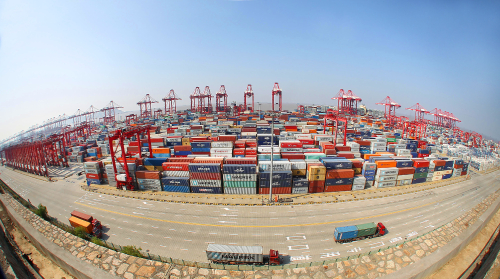|
 |
|
FACILITATING FREE TRADE: Trucks drive by the container terminal of Shanghai Yangshan Port, part of the China (Shanghai) Pilot Free Trade Zone (XU CONGJUN ) |
The FTAAP will help facilitate the process of global trade liberalization and better address the above problems.
APEC's tradition of contributing to world trade talks is long-standing. It has proposed some super-WTO measures such as the liberalization and facilitation of trade and investment as well as early voluntary liberalization.
Since the FTAAP covers North America and East Asia, and given the fact that the world's economic center is shifting to the Asia-Pacific region, such a large-scale free trade agreement will significantly improve the economic integration in this region and accelerate the process of liberalization under the WTO framework.
More importantly, the FTAAP emphasizes next-generation trade and investment issues as well as negotiations on sensitive issues concerning agriculture, rules of origin and intellectual property rights, areas in which loopholes exist in WTO's supervision of non-conventional trade protectionism. The FTAAP can provide models for further improvements in the above rules and contents.
Revitalizing the APEC
In recent years, the number of regional trade agreements (RTAs) and free trade agreements (FTAs) within APEC has increased rapidly, rising from 70 in 2002 to 257 in 2013. Once an economy enters RTAs or FTAs, its neighboring economies have to join or start new RTA or FTA negotiations in order to avoid the losses caused by trade diversion, thus increasing the number of RTAs and FTAs.
Now in the Asia-Pacific region, various overlapping RTAs and FTAs have become obstacles for the overall development of APEC. Different rules of origin adopted by different RTAs and FTAs have aroused a "spaghetti bowl effect," a phenomenon in international economic policy referring to the complication that arises from the application of domestic rules of origin in signing FTAs across nations. The effect leads to chaos in the international trade because the same commodity may be subjected to different tariffs due to different rules of origin. This has not only raised operational and supervision costs in regional cooperation but also gone against the APEC principles of trade and investment liberalization and facilitation.
Although the number of RTAs and FTAs is increasing, the number of exporters using the preferential policies of RTAs or FTAs remains unchanged. In the meantime, RTAs and FTAs have also diverted attention of member economies, transferring resources that could otherwise be pledged to APEC negotiations to RTA or FTA negotiations.
The start of the FTAAP process is an important tool to restrain the growth of RTAs and FTAs and reinvigorate APEC. It is expected that the FTAAP can streamline APEC cohesion, in order to prevent more RTAs or FTAs from being signed among developed members owing to their disappointment at the slow progress in trade and investment liberalization within APEC.
Most of the current RTAs and FTAs in the Asia-Pacific region just cover traditional trade and investment fields, while the FTAAP, a kind of free trade area of higher standards, will cover wider ranges, so it will be difficult for various economies to establish similar RTAs or FTAs. This will break the domino effect in joining or establishing RTAs or FTAs and boost economic integration in the Asia-Pacific region and the APEC development in a very real sense.
The authors are associate researchers with the National Institute of International Strategy of the Chinese Academy of Social Sciences
Email us at: wangjun@bjreview.com | 